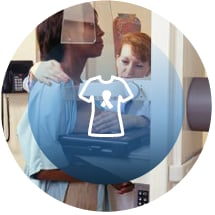Chronic Diseases in America
6 IN 10
Adults in the US
have a chronic disease

4 IN 10
Adults in the US
have two or more
THE LEADING CAUSES OF DEATH AND DISABILITY
and Leading Drivers of the Nation’s $4.1 Trillion in Annual Health Care Costs

THE KEY LIFESTYLE RISKS FOR CHRONIC DISEASE

TOBACCO
USE

POOR
NUTRITION

LACK OF
PHYSICAL ACTIVITY

EXCESSIVE
ALCOHOL USE
NCCDPHP PREVENTS
CHRONIC DISEASE
AND PROMOTES HEALTH
FOR PEOPLE OF ALL AGES

WE WORK TO IMPROVE HEALTH ACROSS THE LIFE SPAN
Where People Live, Learn, Work, and Play

Infants
Reduce the leading causes of infant death and illness.

Children and Adolescents
Help support healthy communities, child care programs, and schools so children can eat well, stay active, and avoid risky behaviors.

Adults
Help adults lead healthy and active lives and increase the use of preventive services like cancer screenings.

Older Adults
Promote quality of life and independence for people as they age.
WHAT WE DO

Find out how chronic
diseases affect
populations in the
United States.

Study interventions to
find out what works best
to prevent and control
chronic diseases.

Fund and guide states,
territories, cities,
and tribes to use
interventions that work.

Share information to help
all Americans understand
the risk factors for
chronic diseases and
how to reduce them.
HOW WE DO IT

Measure
how many Americans
have chronic diseases
or chronic disease
risk factors.

Improve
environments to make it easier for people to make healthy choices.

Strengthen
health care systems to deliver prevention services that keep people well and diagnose diseases early.

Connect
clinical services to community programs that help people prevent and manage their chronic diseases and conditions.
OUR IMPACT

From 2012 to 2018, 16.4 million smokers attempted to quit and 1 million successfully quit because of the Tips® campaign

47% of adults met the aerobic physical activity guideline in 2020.

The Million Hearts® initiative prevented an estimated 135,000 cardiac events from 2012 to 2016, averting $5.6 billion in medical costs.

Teen birth rates fell 63% from 2007 to 2020— an all‑time low.

Use of dental sealants among children from low-income households increased from 22% in 1999–2004 to 39% in 2011–2016.

Over 640,000 people have participated in the National Diabetes Prevention Program lifestyle change program.

Since 1991, the National Breast and Cervical Cancer Early Detection Program has served more than 6.0 million women and found 74,891 invasive breast cancers, 5,066 invasive cervical cancers, and 232,428 precancerous cervical lesions.

From 2010 to 2020 there was an 8% decrease in the number of secondary schools that sold less nutritious snacks or beverages.
